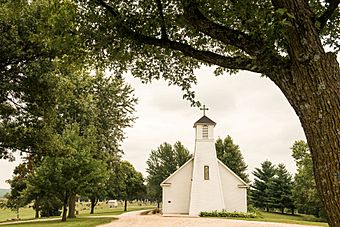St. Patrick's Church (Cumming, Iowa) facts for kids
Quick facts for kids |
|
|
St. Patrick’s Church
|
|
 |
|
| Location | Southwest of Cumming, Iowa |
|---|---|
| Area | 20 acres (8.1 ha) |
| Built | 1868 |
| NRHP reference No. | 78001245 |
| Added to NRHP | December 12, 1978 |
St. Patrick's Catholic Church is a special church located near Cumming, Iowa. It's part of the Diocese of Des Moines. This historic church was built way back in 1868. It's found in the countryside of Madison County, Iowa. In 1978, it was added to the National Register of Historic Places. This means it's an important building in American history. A very famous person, Pope John Paul II, even visited this church in 1979! It was during his first big trip to the United States.
The History of St. Patrick's Church
St. Patrick's Church is important because of its connection to an area called Irish Settlement. This was a farming community in the countryside. Irish immigrants started settling here in the early 1850s.
A priest named Rev. Timothy Mullen helped start this community. He was sent by Bishop Mathias Loras from the Dubuque diocese. His job was to help the small Catholic group in Fort Des Moines. He also wanted to create an Irish community in central Iowa. Bishop Loras bought the first 40 acres of land for this settlement. Many of the first families came from Wisconsin. By 1860, Irish Settlement covered four areas called townships. These were spread across two counties. Forty families lived in Madison County by 1860. By 1870, this number grew to 63 families.
There was a friendly competition about where the church should be built. Some settlers lived north of the North River. Others lived south of it. The church parish was officially started in 1852. The first church was built on the north side of the river. This was the very first parish in what would become the Diocese of Des Moines.
A simple log building served as the first church. Rev. Mullen started it, and Rev. John Kreckel finished it. Traveling priests served the community in the early years. Rev. Francis McCormick became the first full-time pastor in 1857. However, he did not stay for long. The current church building was constructed in 1868. Rev. John Brazill from St. Ambrose Church in Des Moines oversaw its building. It replaced the original log church. A special monument in the church cemetery marks where the old church once stood.
St. Patrick's became part of the Davenport diocese when it was created in 1881. The parish was later divided in 1884 at the North River. People living south of the river formed a new parish in Churchville. Other new parishes started soon after, in St. Mary's and Winterset. Finally, in 1911, the parish was moved to the Des Moines diocese when it was formed.
Pope John Paul II's Visit to St. Patrick's
The idea for Pope John Paul II to visit a small country church came from Archbishop Paul Marcinkus. He was an American who worked at the Vatican. Bishop Maurice Dingman of Des Moines brought him to see St. Patrick's. This happened when they were planning the Pope's trip.
The parish did not have a pastor at that time. So, Bishop Dingman appointed a new priest, Rev. John Richter, to lead the church. The Pope's visit happened on October 4, 1979. Pope John Paul II led a prayer service for 200 people from the parish. He shared a message based on the Acts of the Apostles. It spoke about people gathering for prayer and sharing a meal. He also encouraged them to stay united with their diocese and the larger Church. After visiting St. Patrick's, the Pope celebrated a large Mass at Living History Farms near Des Moines.
The Architecture of St. Patrick's Church
St. Patrick's Church is a wooden building. It measures about 66 feet long and 34 feet wide. It has a room called a sacristy attached to the back. This room is about 24 feet long and 12 feet wide.
The church has five sections along its length. Each section has a beautiful round-arch Stained glass window. A small round window, called a rose window, is located above the altar. The roof over the main part of the church is gently sloped. It has a gable shape with decorative edges.
The front of the building has a unique bell tower. It gets narrower as it goes up. The part of the tower where the bell is has a round-arch louver on each side. A hipped roof covers the top of the tower, with a cross on top.
The church is surrounded by about 20 acres of land. This property includes trees, grassy areas, and farm fields. The parish cemetery is also on the property. Many of the first people who belonged to the church are buried there.



